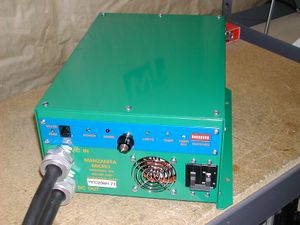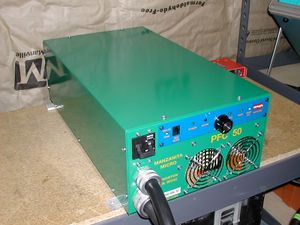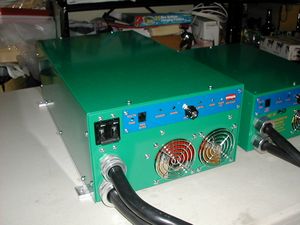|
General Disclaimer: (HV) (DC) injury or death hazard, use at your own risk, may void warranty. |
MM-PFC
| Click show for a short list of the current PHEV conversion and kit options for the Toyota Prius. |
|---|
|
For Prius conversion details see the Prius PHEV article and comparisons table.
|
|
--={ PiPrius
}={ Process
}={ fan control
}={ Manzanita Micro
}={ MM-PFC
}={ Mk 3 Reg
}=--
|
|---|
|
--={ More Vehicles: AVI }={ WhiteBird }={ GrayPearl }={ GreenCarCo }=-- |
 Team Photo from the PriusPlus conversion of Sven's Prius from Nov 2006.
|
Contents
The MM-PFC (Power Factor Corrected) line of battery chargers are produced by Manzanita Micro and used in their PiPrius conversion kits. An enhanced version of the PFC30 named the PFC40H is used in the conversions. This enhanced charger includes three externally triggered tunable voltage targets and two current (Amps) set points one of which is adjustable by the standard current nob. These new features are driven by a CAN-View which when PHEV mode is enabled powers up the charger, sets it to full current, and enguages V2 which is the lower of two NiMH voltage setpoints. Also based on SOC as reported by the Prius BMS computer the CAN-View can triger V3 which is a higher NiMH voltage that induces State Of Charge Drift, raising the precieved SOC.
PFC Chargers
The PFC series of chargers are designed to be as versatile and as powerful as possible within the limits of residential power infrastructure. Three models are available: The PFC20 that is designed to operate from a 20 amp 240 volt outlet, the PFC30 that is designed to operate from a 30 amp 240 volt dryer outlet, and the PFC50 that is designed to operate from a 50 amp 240 volt range outlet. They will operate at half power (same line current) from a 120 VAC source.
Extremely versatile input and output voltages
These chargers will operate on any voltage from 60 volts to 240 volts AC at either 50 or 60 Hz. Current is limited to ~20 amps input or output for the PFC20, ~30 amps input or output for the PFC30 and ~50 amps input or output for the PFC50. There are no switches to adjust to change the input voltage. The charger automatically uses whatever voltage is provided.
The charger output can be adjusted for any charging voltage from 12 volts to 450 volts with the twist of a 20 turn trimmer pot. There is no need to buy different chargers for the different electric vehicles you may need to charge. The charger can be reprogrammed to another pack voltage if you change the number of batteries in your system. There is no longer a need to buy another charger every time you add or take batteries out of your system.
The actual power delivered is a function of input and output voltage. Refer to the performance charts for the various products to see how much power to expect in your application.
Extremely powerful for an onboard charger
The essential ingredient for fast recharge times is to deliver high power to the battery. The key to polite opportunity charging is to be able to share outlets with other equipment and make efficient use of limited current. The PFC line of chargers have a throttle to allow the chargers to be turned down to operate on very limited power sources such as small generators. The PFC20 has demonstrated putting 2200 watts into a 156 volt battery pack from a 2400 watt generator. Efficiency and power factor are both better than 0.9.
The PFC20 can put 5 kW into a 450 volt battery from 240 VAC input or 2500 watts into a 180 volt battery from 120 VAC. The PFC20 does this while operating from a 20 amp circuit breaker.
The PFC20 weighs 16 pounds and resides in a box that is 13 x 9 x 5.5 inches.
The PFC30 weighs 17 pounds and resides in a box that is 13 x 9 x 5.5 inches.
The PFC50 weighs 42 pounds and resides in a box that is 19.5 x 10.5 x 6.5 inches.
More information available at the company homepage http://www.manzanitamicro.com
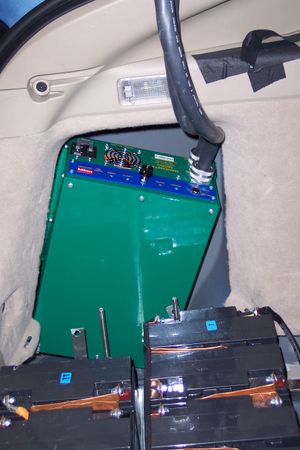 PFC40H installed in PriusBlue |
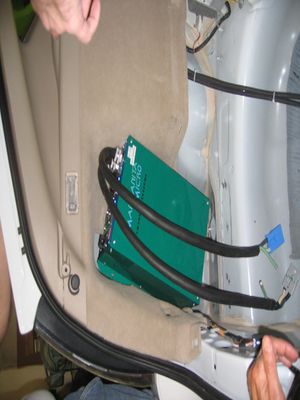 PFC40H installed in WhiteBird |

